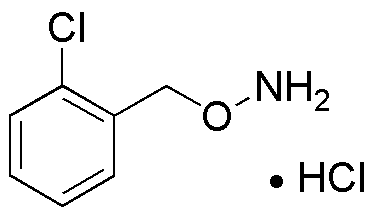O-(2-Chlorobenzyl)hydroxylamine hydrochloride is widely utilized in research focused on:
- Pharmaceutical Development: This compound is used in the synthesis of various pharmaceuticals, particularly in the development of antihypertensive and anti-inflammatory drugs, offering a pathway to create more effective treatments.
- Organic Synthesis: It serves as a versatile reagent in organic synthesis, enabling chemists to create complex molecules with precision, which is essential in both academic and industrial laboratories.
- Analytical Chemistry: The compound is employed in analytical methods for detecting and quantifying amines and aldehydes, providing reliable results that are crucial for quality control in manufacturing.
- Biochemical Research: Researchers utilize it to study enzyme mechanisms and interactions, helping to uncover new biological pathways and potential therapeutic targets.
- Environmental Chemistry: It can be applied in environmental studies to assess the degradation of pollutants, contributing to efforts in pollution control and remediation strategies.
General Information
Properties
Safety and Regulations
Applications
O-(2-Chlorobenzyl)hydroxylamine hydrochloride is widely utilized in research focused on:
- Pharmaceutical Development: This compound is used in the synthesis of various pharmaceuticals, particularly in the development of antihypertensive and anti-inflammatory drugs, offering a pathway to create more effective treatments.
- Organic Synthesis: It serves as a versatile reagent in organic synthesis, enabling chemists to create complex molecules with precision, which is essential in both academic and industrial laboratories.
- Analytical Chemistry: The compound is employed in analytical methods for detecting and quantifying amines and aldehydes, providing reliable results that are crucial for quality control in manufacturing.
- Biochemical Research: Researchers utilize it to study enzyme mechanisms and interactions, helping to uncover new biological pathways and potential therapeutic targets.
- Environmental Chemistry: It can be applied in environmental studies to assess the degradation of pollutants, contributing to efforts in pollution control and remediation strategies.
Documents
Safety Data Sheets (SDS)
The SDS provides comprehensive safety information on handling, storage, and disposal of the product.
Product Specification (PS)
The PS provides a comprehensive breakdown of the product’s properties, including chemical composition, physical state, purity, and storage requirements. It also details acceptable quality ranges and the product's intended applications.
Certificates of Analysis (COA)
Search for Certificates of Analysis (COA) by entering the products Lot Number. Lot and Batch Numbers can be found on a product’s label following the words ‘Lot’ or ‘Batch’.
Numéro de catalogue
Numéro de lot/série
Certificates Of Origin (COO)
This COO confirms the country where the product was manufactured, and also details the materials and components used in it and whether it is derived from natural, synthetic, or other specific sources. This certificate may be required for customs, trade, and regulatory compliance.
Numéro de catalogue
Numéro de lot/série
Safety Data Sheets (SDS)
The SDS provides comprehensive safety information on handling, storage, and disposal of the product.
DownloadProduct Specification (PS)
The PS provides a comprehensive breakdown of the product’s properties, including chemical composition, physical state, purity, and storage requirements. It also details acceptable quality ranges and the product's intended applications.
DownloadCertificates of Analysis (COA)
Search for Certificates of Analysis (COA) by entering the products Lot Number. Lot and Batch Numbers can be found on a product’s label following the words ‘Lot’ or ‘Batch’.
Numéro de catalogue
Numéro de lot/série
Certificates Of Origin (COO)
This COO confirms the country where the product was manufactured, and also details the materials and components used in it and whether it is derived from natural, synthetic, or other specific sources. This certificate may be required for customs, trade, and regulatory compliance.


